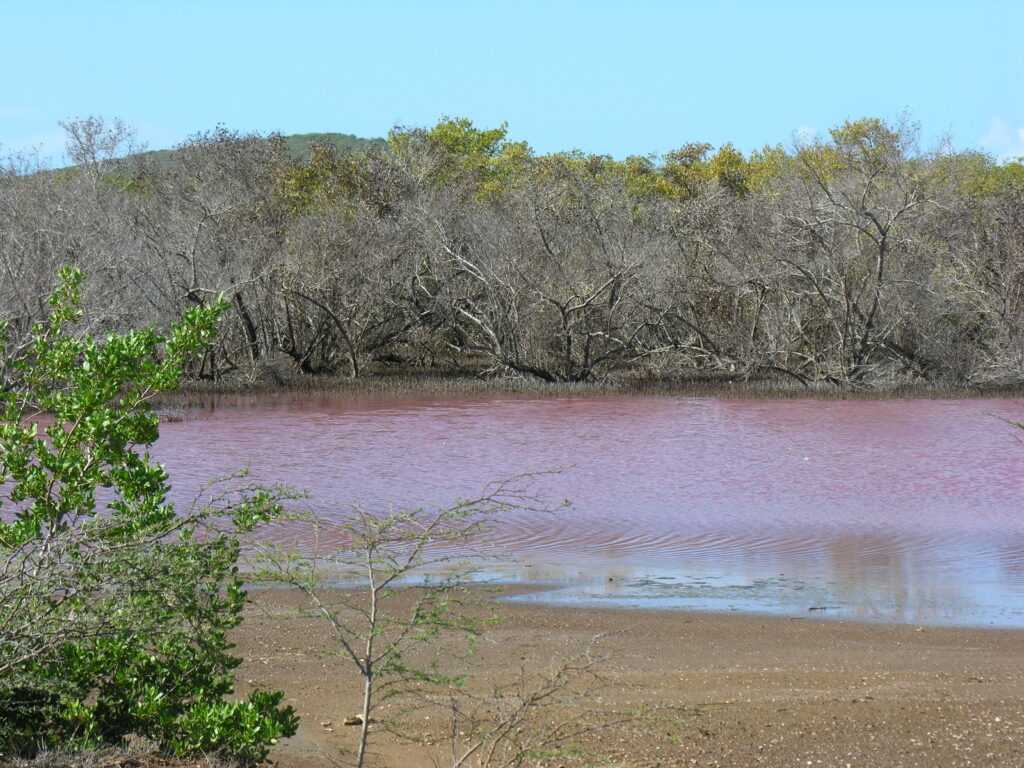
The Great Pond on the South Shore of St. Croix has gone through dramatic changes since Hurricane Hugo in 1989. Some of the changes are natural, but human activity has played its part, too.
Now the Department of Natural Resource Division of Coastal Zone Management East End Marine Park is interested in restoring it as the wetland resource it once was and is interested in hearing what island residents think about the idea.
For most of its recorded history, the pond has been a tidal lagoon with ocean tides full of shrimp, fish, crabs, and lobster flowing in and out. But Hugo initiated a string of events that has brought the pond to its present state, cut off from the ocean, and basically a high-salinity dead zone.
According to John Farchette, East End Marine Park Interpretive ranger, Hugo was a flooding event that brought a great deal of sediment into the pond. It was never very deep, maybe four feet at the deepest. One reason for the sediment flow was that seven retention ponds built in the watershed area by the U.S. Department of Agriculture in the 1960s to retain water for livestock had not been maintained and had become filled with sediment themselves. Instead of retaining water and absorbing it to refresh the aquifer, the ponds were reflecting it. Discussion is ongoing with federal officials to get funds to fix that problem.
As Great Pond filled with sediment, it not only was no longer a home for fish that fishermen would go after when it was too rough to fish in the ocean. Mangroves have been sprouting in the middle of it. Then in 2015 came the second part of what Farchette refers to as a “double whammy.”
Sargassum started hitting large areas of the South Shore and the channel from the ocean to the pond became blocked. The mangroves that came with the sediment growth were dealt a death blow as the salinity in the pond doubled that of what is in the ocean.
The storms this summer have filled the pond, and Farchette believes it is just a matter of time before the pond breaks its own channel to the ocean, but he fears what could happen before that time. Southshore Road where it bends sharply east, east of Sally’s Fancy, is near the pond and the pond could rise over this main thoroughfare.
The University of the Virgin Islands researched the feasibility of restoring Great Pond as a wetland, but Farchette says before the federal government will commit any funds to the project, what residents think about such a project needs to be ascertained.
The East End Marine Park expects to host a public event next spring to provide information to residents about what could be Great Pond’s future. The East End Marine Park oversees the shore on the East End where the barrier reefs are “most productive and most fragile and vulnerable to anthropogenic and natural disasters,” according to Farchette.
Great Pond was under the park’s jurisdiction when it was open to the ocean. Anyone with questions about Great Pond or the Marine Park can call Caroline Pott at 340-718-3367 or Hilary Lohman at 340-773-1082 in Coastal Zone Management.
Editor’s Note: The lead paragraph of this story has been corrected to say that the Great Pond is located on the South Shore of St. Croix.






Restore the great pond in the south shore, and convert the stinky pond at Southgate into a Marina! We are woefully short of protected marinas on St. Croix.